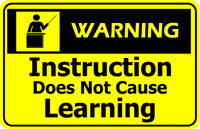I’ve been listening to lots of talk lately about how to “fix” education. Mostly, from people not currently involved in the design or delivery of education. And there are lots and lots of theories.
(I’d imagine that when plumbers get together for a beer, they laugh about how architects think they know how to “fix” plumbing. It’s always fun to listen to people who have used a complex system pontificate about how to redesign it.)
And like the plumbers, it looks pretty simple to me. The problem is that the people sitting on top of the system don’t really want to think about all the crap that flows through the system. And eventually the sheer amount of crap in the system plugs it up, and the system stops working.
Roto-Rooting K-12 Education
 Many years ago, we all headed outdoors to do our business. There was a little house with a half-moon on the door and a Sears catalog. That worked just fine, until the whole idea of indoor plumbing came along and pretty soon there wasn’t much of a market for outhouse manufacturers. It didn’t mean that they weren’t high-quality outhouses, or that the people who built them didn’t care a lot about their product.
Many years ago, we all headed outdoors to do our business. There was a little house with a half-moon on the door and a Sears catalog. That worked just fine, until the whole idea of indoor plumbing came along and pretty soon there wasn’t much of a market for outhouse manufacturers. It didn’t mean that they weren’t high-quality outhouses, or that the people who built them didn’t care a lot about their product.
But things had changed. Technology had come along that was more efficient and better served the needs of the user.
So even if we’d paid more for the outhouses, or given them incentive bonuses for taking higher levels of crap than the average — it wouldn’t have fixed the basic problem.
A Better Way To Do It
The type of learning that we’re trying to support in K-12 is, in large measure, not very difficult to provide. Much of it is rote memorization, matching patterns, and understanding simple relationships. The content (reading, writing and ‘rithmetic) hasn’t changed markedly since I was a tiny tot.
What has changed is the availability of technology to deliver this learning. Beginning with Sesame Street and the Muppets, we saw that the use of well-designed video really worked for learning. Then video games showed us that higher level learning could also be very effective. Now e-learning provides more than half of the training that happens in the corporate arena.
But our school districts keep telling us that we need more money to find and hire highly skilled teachers for the classrooms, and pay them incentives if they succeed at teaching Johnny to read.
(In the corporate world, we call this “Instructor Led Training” or “ILT” — and there’s less and less of it every year. It’s very expensive, often gives inconsistent results and isn’t very flexible for individual learners.)
But – But – But
No, I’m not saying we don’t need to have children spend time learning social skills. Or understanding how to work with others, be part of a team, support diversity, appreciate fine art or hug trees. Those are things that technology-driven learning doesn’t always do well — yet. A human instructor is great for that kind of content.
But right now, 50% of the kids in my state don’t graduate from high school. The lion’s share of graduates don’t read at grade level. Making change is a challenge. Basic economics is a mystery. These are skills that could be taught easily (for most students) with technology, leaving our teachers lots of time for the outliers and special situations.
But the people sitting on top of the system just keep downloading more crap.

{ 0 comments… add one now }